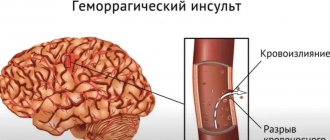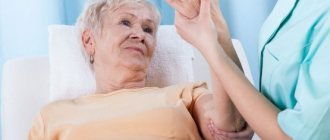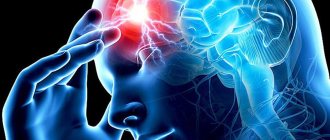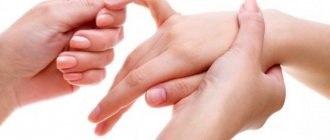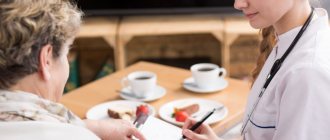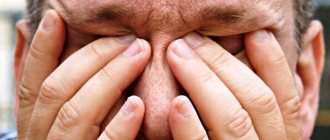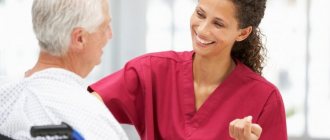Stroke is an acute disease that is accompanied by the death of brain cells due to acute cerebrovascular accident. It manifests itself with general cerebral and local symptoms. The development of a stroke is possible in two scenarios: either after 24 hours from the onset of the disease, its symptoms persist, or death occurs.
Diagnostic examination for developing stroke includes:
- clarification of complaints and history of the disease;
- neurological examination;
- blood tests (determining the level of enzymes and blood glucose, the state of the coagulation and anticoagulation systems).
- Dopplerography - study of blood flow in the vessels of the neck and brain;
- computed tomography helps distinguish between ischemic and hemorrhagic strokes;
- Magnetic resonance imaging is more informative in cases of developing stroke;
- magnetic resonance angiography and computed tomography angiography are non-invasive methods for assessing the carotid and cerebral arteries;
- an electrocardiogram allows you to assess the condition of the heart muscle;
- Echocardiography (EchoCG) is a research method with which doctors at the Yusupov Hospital identify blood clots in the cavities of the heart, which allows them to assess the risk of developing a recurrent stroke.
Make an appointment
Types of brain strokes
The most common ischemic stroke (infarction) of the brain - 85% of cases, hemorrhagic stroke occurs in 15% of cases. Strokes can be caused by several reasons:
- formation of thromboembolism in heart diseases;
- acute circulatory disorders in the cervical and large cerebral arteries;
- disturbance of blood circulation in the small arteries of the brain during the acute course of the process.
Classification of strokes
Strokes are classified according to the causes of circulatory disorders and the duration of neurological symptoms. At the Yusupov Hospital, the patient will undergo a diagnostic examination, which will allow the type of stroke and the area of brain damage to be very quickly and accurately determined. When a patient is admitted to the clinic, a number of studies are carried out as prescribed by the doctor:
- MRI – magnetic resonance imaging;
- CT – computed tomography;
- Doppler ultrasound;
- cerebral angiography.
Classification of ischemic stroke (infarction) of the brain:
- hemorheological blockage of cerebral vessels. This condition develops with increased blood clotting and platelet aggregation;
- embolic stroke. Occurs in 20% of cases of ischemic stroke, develops when an artery is blocked by emboli (intravascular substrates) that enter small vessels from larger blood vessels;
- atherothrombotic stroke. Found in 50% of patients with ischemic stroke. A blood clot forms at the site of the atherosclerotic plaque, leading to blockage of the vessel;
- lacunar stroke. Arterial hypertension leads to the development of atherosclerosis, which causes narrowing of small arteries and reduced blood flow to areas of the brain. Occurs in 25% of cases;
- hemodynamic stroke. The pathological condition is caused by a sharp narrowing of a large vessel in the brain due to a drop in blood pressure during heart failure. Blood flow to a part of the brain stops, and an ischemic stroke develops.
Classification of hemorrhagic strokes:
- an outpouring of blood when a vessel ruptures in the brain tissue - parenchymal hemorrhage;
- formation of hematoma in the ventricles of the brain - intraventricular hemorrhage;
- hemorrhage into the cavity between the pia mater and the arachnoid membrane is called subarachnoid;
- Epidural, subdural and mixed forms of hemorrhages are quite rare.
Classification according to the duration of neurological symptoms:
- minor stroke – symptoms manifest from one day to three weeks. Recovery from one day to three weeks;
- transient ischemic attack - symptoms last for about a day, recovery within a day;
- Completed ischemic stroke – symptoms of the disease have been observed for more than three weeks, recovery does not occur for more than three weeks.
Causes of spinal stroke
Most patients with this pathology are diagnosed with ischemic lesions, and hemorrhages are detected much less frequently. Blood flow disorders are usually caused by primary or secondary vascular lesions.
The causes of primary vascular lesions are:
- myocardial infarction;
- hypertonic disease;
- atherosclerotic lesions of vessel walls;
- thrombosis;
- varicose veins;
- embolism;
- aneurysms;
- vasculitis of infectious-allergic origin.
The development of secondary vascular lesions is caused by:
- diseases of the spine (including osteochondrosis and tuberculous spondylitis);
- tumor lesions of the spine and spinal cord;
- inflammation of the spinal cord membranes.
Other causes of spinal strokes include:
- traumatic injuries;
- diseases of the endocrine system;
- blood pathologies.
Important: When two or more predisposing factors are combined, the likelihood of acute disturbance of spinal blood flow increases sharply.
Regardless of the cause, brain tissue is affected. During ischemia (heart attack), the nutrition and oxygen supply to the meninges is disrupted, and against the background of hemorrhage, compression occurs, leading to the destruction of individual areas.
Periods of stroke
Among the huge number of neurological diseases, stroke is the most important problem. Hemorrhage in the brain leads to disruption of intracranial circulation, neuronal necrosis and disruption of vital body functions.
In ischemic stroke, a number of processes are observed that together lead to the death of neurons. Cell destruction occurs against the background of cerebral edema. At the same time, the brain increases in volume and intracranial pressure increases.
Due to cell swelling, displacement of the temporal lobe is observed, as well as infringement of the midbrain.
Compression of the medulla oblongata may also occur due to wedging of the cerebellar tonsils into the foramen magnum. This process quite often leads to death. Therefore, early hospitalization of the patient is extremely important.
When the first signs of an ischemic stroke appear, medical assistance should be provided within the first three hours, otherwise the prognosis is disappointing.
There are several periods of ischemic stroke:
- acute;
- spicy;
- early recovery period of stroke;
- late recovery;
- stage of residual effects.
The most acute period
In the first three hours, it is possible to restore blood flow and eliminate or reduce neuronal death through the use of thrombolytics. It is also possible to administer drugs into the stroke area itself, which helps prevent the development of complications.
Then doctors take measures to restore pressure, carry out rehydration, dehydration and oxygen therapy.
During the most acute period of a stroke (from 4 to 5 hours after the attack), the patient should be under the close supervision of a doctor in a hospital setting.
Acute period
The period up to 14 days after the attack is considered acute. The patient continues to undergo treatment in a specialized department of the hospital. He is undergoing drug therapy aimed at:
- reduction of cerebral edema;
- maintaining normal blood viscosity and coagulability;
- maintaining normal functioning of the cardiovascular system;
- relapse prevention;
- maintaining normal blood pressure.
Early recovery period
The early recovery period is considered to be the period from 2 to 6 months after a stroke. At this stage, complex treatment is carried out:
- the patient takes medications according to an individual treatment regimen;
- in case of speech impairment, a speech therapist works with the patient;
- various manipulations are prescribed to restore sensitivity of the limbs and other parts of the body (massages, baths, acupuncture and others);
- physical therapy – the method helps strengthen ligaments and muscles.
Late recovery period
The late recovery period is the time six months after the stroke. At this stage, the results of treatment and rehabilitation measures taken during the early recovery period are already visible.
The patient's finger sensitivity is restored and motor skills improve. It is extremely important not to stop the complex of procedures. Rehabilitation after a stroke is a long and labor-intensive process.
Period of residual effects
The time from one to two years after a stroke is considered the residual period. At this stage, it is important to follow all doctor’s instructions and take measures to prevent a recurrent stroke.
Rehabilitation specialists and neurologists at the Yusupov Hospital create a treatment and rehabilitation program individually for each patient, which allows achieving high results in recovery after a stroke.
Expert opinion
Author: Vladimir Vladimirovich Zakharov
Neurologist, Doctor of Medical Sciences, Professor, Head of the Center for Diagnostics and Treatment of Memory Disorders
According to statistics provided by WHO, stroke ranks third in prevalence among all neurological diseases. Doctors note an annual increase in incidence. In Russia, 400 thousand new cases of stroke are registered every year. More than 30% of them are fatal. Acute cerebrovascular accident is not a disease characteristic of older people. The disease can be diagnosed in 5-year-old children. A distinctive feature of old age is considered to be a greater number of factors predisposing to the development of stroke.
At the Yusupov Hospital, diagnosis of cerebrovascular accidents is carried out using modern medical equipment. CT and MRI make it possible to assess the size of the pathological lesion, its location, and the type of stroke. Treatment is developed individually for each patient. The drugs used meet quality and safety standards. If necessary, surgical intervention is performed. During the rehabilitation period, each patient is prescribed a course of physiotherapy and a complex of physical therapy. Experienced massage therapists work the muscles, helping to restore lost functions.
Main assistants
1. Massage and medicinal treatment
Massage is necessary to reduce muscle tone. In order for it to be as useful as possible, it is better to entrust it to a specialist in the first month after discharge, and then relatives can, with his help, master the basic techniques and continue the procedure daily - after a stroke, regularity of exposure is important. In addition, it is recommended to take drugs that reduce muscle tone by reducing the intensity of nerve signals. The dosages of these drugs are strictly individual and should be selected by the attending physician.
2. Constant conversations with the patient
Relatives and friends of a person who has suffered a stroke should talk to him as much as possible. Even discussing ordinary everyday situations greatly contributes to the patient’s restoration of both understanding the speech of others and “speech to oneself.” If it seems that you were not understood, you need to repeat the question addressed to the patient, while speaking clearly, loudly and slowly.
It is useful to listen to the radio and watch TV shows together, incomprehensible parts of which need to be clarified at first. Even discussing household chores and small events in the presence of the patient (but only those that indirectly concern him and do not traumatize him) will contribute to the restoration of his speech.
In the presence of the patient, you cannot talk about his speech difficulties. On the contrary, it is necessary to record all his successes, the slightest improvements in his condition. How the patient will overcome his difficulties often directly depends on the tact and sensitivity of relatives.
There should be no “speech isolation” of the patient when he is left to his own devices. In this case, relatives should rely on those speech functions that the stroke survivor has preserved in whole or in part. If it’s understanding the speech of others, you need to speak more yourself; if it’s reading, you need to discuss what you read during the day. If the patient repeats words and phrases well, you need to focus on these activities. Be patient! Your efforts will not be in vain!
Causes and consequences of stroke
The following causes of stroke are known:
- age. People at risk for stroke include older people, especially those who have high blood pressure, lead a sedentary lifestyle, are overweight, or smoke or drink heavily. Currently, stroke is increasingly developing in young people;
- floor. In most age groups, stroke is more common in men than in women. However, it is more severe and more often fatal in women. This is due to the use of contraceptives, hormonal imbalance and emotional imbalance in women;
- family history. In most cases, the closest relatives of patients suffering from stroke have suffered acute cerebrovascular accident;
- smoking. Individuals who smoke more than 20 cigarettes per day have a 2-fold increased risk of stroke;
- nutrition. The predominance of saturated fats, light carbohydrates and excess amounts of table salt in the diet contributes to an increase in blood pressure, which is the main factor in hemorrhagic stroke;
- insufficient physical activity. Lack of regular exercise increases the risk of obesity and increases poor circulation, which contributes to the development of stroke.
- drug use. Drugs, especially methamphetamine and cocaine, are a major factor in the development of stroke in young people. Anabolic steroids, which athletes often take, also increase the likelihood of stroke.
- diseases of the heart and blood vessels. People suffering from diseases of the cardiovascular system, especially those accompanied by cardiac arrhythmias, and peripheral vascular pathology are at increased risk of developing stroke;
- a stroke increases the risk of acute cerebrovascular accident by 10 times;
- Arterial hypertension is the cause of 70% of strokes. Patients with hypertension have a 10 times higher risk of stroke than people with normal blood pressure.
- high cholesterol levels increase the risk of developing atherosclerosis of the cerebral arteries and impaired blood flow through the cerebral vessels;
- Coronary heart disease increases the risk of stroke. Anti-clotting drugs, which are used to treat cardiovascular diseases, dissolve blood clots but also increase the risk of hemorrhagic stroke.
- Atrial fibrillation is a major risk factor for stroke associated with heart rhythm disturbances. 2-4% of patients with atrial fibrillation without warning signs of cerebral bleeding develop a stroke.
The consequences of a stroke are impaired motor, speech, visual, cognitive function, and sensitivity disorders. They are prevented at the Yusupov Hospital by a team of specialists, which includes neurologists, cardiologists, speech therapists, psychotherapists, and rehabilitation specialists.
Seizures after stroke
Some consequences of a stroke can be treated and restored with adequate medical care. These consequences include seizures that occur in women and men after an ischemic or hemorrhagic stroke.
The development of convulsive syndrome is caused by the death of brain neurons and the formation of a focus of necrosis. The body's response to this process is the activation of other neurons to restore blood circulation and stop the pathological process. Necrotic tissue is replaced by a cavity filled with fluid; when a cyst forms, a person does not feel discomfort. However, when neurons are irritated by the cyst, seizures can occur.
After a stroke, seizures can manifest in patients in the form of:
- numbness of one or both limbs at the same time, feeling of a wooden leg or arm;
- contractions of the muscles of the face and neck, resulting in a “mask-like face”, tilting of the head to one side or asymmetry of the face on one side;
- contractions of the facial muscles against the background of numbness of the limbs.
Some patients experience mild tremors after a stroke, while other patients experience short-term cramps throughout the body.
Temperature after stroke
Temperature during a stroke is an indicator of cerebral hemorrhage, hemorrhagic stroke. With an ischemic stroke, the temperature in most cases is slightly lowered; with a hemorrhagic stroke, the temperature rises.
Timely medical care reduces the risk of developing severe complications. After a stroke, it is difficult to deal with high fever - antipyretics can aggravate the condition of a patient with a hemorrhagic stroke, and in the case of an ischemic stroke cause hemorrhagic transformation.
Temperature after stroke: causes and treatment
Temperature during a stroke is a very important indicator of the patient’s condition. It is most often used to determine the degree of brain damage in a patient. Temperature readings up to 38 degrees are considered to be the maximum permissible.
Stroke studies have shown that the majority of stroke patients had a normal mean temperature upon admission to the clinic. In patients with extensive strokes, the temperature began to rise after a few hours (4-6) to 40 degrees. In patients with moderate strokes, the temperature rose to 40 degrees 12 hours after the stroke. A mild stroke most often occurs without fever or with a slight rise in temperature.
Complications after a stroke
After a stroke, fever often occurs due to the following complications:
- the damage occurred over a large area of the brain;
- swelling of brain tissue has developed;
- during a stroke, the thermoregulation center in the brain was damaged;
- complication after a stroke – pneumonia;
- an allergic reaction to medications developed.
In cases where the cause of the increase in temperature is its central genesis, doctors perform craniocerebral hypothermia. The brain is cooled through the outer covering of the head using special equipment. This method increases the brain's resistance to oxygen starvation, reduces the risk of developing cerebral edema, relieves existing edema, and reduces tissue temperature.
How is leg function restored?
For patients with motor limitations, initial training emphasizes the importance of compensatory strategies. For example, patients learn to transfer from a bed to a wheelchair for mobility, and self-care is performed using an unaffected limb. Recent trials highlight the importance of regular practice of the movements associated with a specific task that gradually increases in difficulty.
To restore the left leg, training in compensatory techniques is required. Performing individual exercises with components of impaired movement of the affected limbs allows you to perform increasingly complex and specific actions over time. First, perform simple exercises in a lying position. An assistant lifts the injured limb above the surface and performs flexion and extension movements. The patient is gradually able to independently perform simple, similar leg movements in a lying and sitting position. At the same time, it is necessary to concentrate on the accuracy, speed and duration of each task.
Restoring walking after a stroke is a primary goal and a reasonable expectation for most patients. Individuals who develop at least partial counter-gravity motion for hip flexion and knee extension will be able to progress over time from single steps between parallel bars to slow walking short distances using a walker or cane. Special plastic ankle and foot orthosis can stabilize weak ankle and knee to improve foot clearance and prevent knee dislocation.
Regaining the ability to walk even short distances requires considerable practice. However, already in the initial stages of rehabilitation, it is necessary to spend at least 15 minutes a day performing mobility tasks. When mastering walking skills, one should strive to increase walking speed to 0.75 m/s, which will eliminate restrictions on movement in the community.
Repeated practice that varies tasks and their requirements is advisable. A simple exercise that can be practiced at home. Ask the victim to go to the shelf, stand on his toes, transfer his body weight to it, and then slowly stand on his foot. Then offer to take books from the top shelf, and, sitting down, put them on the floor, and then return to the bed. Try to practice this exercise for 20 minutes several times a day until your performance is satisfactory.
Improving strength and endurance at home can be achieved by asking a person to perform exercises with a fitness band, gradually introducing variety into the tasks and making them more complex. You can imitate pedaling a bicycle by lying down.
If you have an exercise machine at home, you can walk on a mechanical treadmill. In this case, it is necessary to increase the time of training on the simulator, achieving walking for 30 minutes. It is very important to control the speed of movements, and if shortness of breath occurs, slow down the pace of walking.
It is necessary to gradually introduce activities aimed at performing everyday tasks and meeting the daily needs of the patient and his family. For example, ask the victim to clean mirrors around the house to practice squats, lifts, steps, and balance.
After 6 months, individual goal setting is required. There is a need to improve the skills needed to perform routine household activities and activities outside the home necessary to meet needs. Ask the victim to increase their walking speed and walking distance by 25%. It is advisable to examine commuting conditions and routes to develop strategies that will allow at least limited performance of professional functions.
Randomized trials show that patients who walk slowly (i.e., less than 0.4 m per second) can significantly improve their speed and endurance, even when treatment begins 3 to 12 months after the stroke. Successful interventions include one or more bouts of 10 to 20 hours of targeted exercise over four weeks, such as outdoor walking, treadmill running, obstacle courses, and exercises to improve leg strength and balance. Treadmill training using partial body weight support (attaching a suspension lift to a strap on the patient's chest) allows more steps to be taken at higher speeds than would otherwise be possible.
Patients with hemiparesis have decreased rates of muscle force production, strength, speed of sequential movements, and resistance to fatigue. Although neural factors that influence motor control are responsible for many disorders, changes in muscle fibers and atrophy caused by disuse can contribute negatively. In randomized trials, progressive resistance exercise was performed three to four times per week for a period of 6 to 12 weeks by patients with adequate motor control, improving strength and functional performance. Physical fitness often declines in disabled people, but trials show gains with progressive aerobic exercise. For example, walking on a treadmill three days a week, tailored to each patient's tolerance, even if exercise begins years after the stroke.
Attention to additional and modifiable conditions that may influence the effectiveness of rehabilitation efforts is important and warranted. For example, painful osteoarthritis or heart disease may limit exercise tolerance. Other modifiable factors that limit a person's participation in exercise include sleep disturbances, pain, medication side effects (such as orthostatic hypotension and impaired concentration), mood disorders, and urinary incontinence or retention.
Signs and symptoms after a stroke
The symptoms of a stroke largely depend on the cause of the disease. The first signs of a stroke are the following symptoms:
- sudden numbness or weakness in an arm or leg on one side of the body;
- confusion;
- Strong headache;
- speech disorder;
- decreased visual acuity;
- dizziness;
- loss of balance or coordination.
The speed at which symptoms of an ischemic stroke appear may indicate its origin: if an acute cerebrovascular accident is caused by an embolism, the disease is sudden. Headache and seizures may develop within seconds of arterial thromboembolism.
In patients with the consequences of a stroke, there are three main types of disorders:
- damage, defect. The following damages after a stroke are distinguished: motor, cognitive, emotional-volitional, speech, visual, sensory, sexual and pelvic disorders;
- impaired ability. Expressed in impairment of walking and self-care;
- impairment of social functioning. It is expressed in the restriction of the implementation of the social role that was the norm for the patient before the illness.
Symptoms after a stroke go away if doctors begin rehabilitation measures in a timely manner. When a patient is admitted to the neurology clinic of the Yusupov Hospital, a team consisting of the following specialists is included in the rehabilitation process:
- neurologists;
- therapists;
- kinesitherapy specialists;
- aphasiologists;
- massage therapists;
- physiotherapists;
- acupuncturists;
- psychologists;
- biofeedback specialists.
Muscle pain due to stroke
Muscle pain after a stroke, which should be treated immediately, occurs in most patients. Muscle soreness can interfere with the body's recovery. Post-stroke pain can be strategic or thalamic. Strategic pain occurs in the area of the brain that controls sensations, particularly pain, and is caused by spasms. Thalamic pain appears after a stroke in one side of the body several months after the circulatory disorder.
The occurrence of pain after a stroke can be associated with various factors. Neurologists and rehabilitation specialists advise patients to follow recommendations that will prevent the onset of this condition. Measures to prevent muscle pain after a stroke:
- do not take hot baths;
- prefer clothes made from natural materials, do not wear light clothes;
- be in a comfortable position and avoid tightly grouping the body;
- do not put pressure on the affected side;
- use special devices for paralyzed and weakened limbs;
- fix the paralyzed arm while sitting so that the pain localized in the shoulder does not get worse;
- When moving, support from another person is desirable.
If you have pain in the legs after a stroke, it is important to trust treatment to qualified neurologists and rehabilitation specialists.
foot legs
And the best part was that I found out from a rehabilitation specialist that I had serious problems with my foot after a stroke.
That is, I understood why I walked, moving my leg in a semicircle, as if from the side.
I had a foot that would come out on the outside when I moved it while walking.
Then, the rehabilitation specialist prescribed me to wear an orthosis so that my leg could walk correctly.
Of course, I have been doing exercises for my feet since the fall of 2017, but I couldn’t fix my foot.
Consequently, I did not understand why I could not walk normally, that is, move normally.
And only now, three and a half years later, I understood why I couldn’t walk normally!
I couldn't feel my leg and therefore couldn't control its movements.
From the moment I gradually began to feel my leg more and more, I began to try to correct it.
Nerves, nerves and nerves play a very important role in controlling your torso!
Which are connected to the brain!
For example, from the very beginning of recovery, I realized that two components are very important - therapy and exercise therapy, that is, 50% to 50%.
Features of stroke in older people
Age is one of the significant factors in the development of acute vascular pathologies of the brain that impair blood circulation. Diseases of the blood vessels in older people are much more severe than in young people. This is due to physiological changes in the body, and in particular in the central nervous system, such as:
- reduction in brain volume and weight;
- thinning of the leptomeningeal membranes;
- senile neuronal atrophy;
- degenerative changes in white matter;
- decreased functional activity of neurons;
- neuronal death caused by electrolyte imbalance;
- reduction of the blood-brain barrier;
- pathological changes in the cerebral ventricles.
About 80% of stroke cases are diagnosed in people over 70 years of age. And, unfortunately, the prognosis for recovery is very often unfavorable. The consequences of stroke in older people are difficult to predict, since it is difficult for such patients to choose effective therapy.
Causes of stroke in older people
Among the causes of stroke in older people, etiological factors and risk factors are distinguished. The former cause the disease itself, while the latter increase the likelihood of pathology occurring. The main causes of acute disorders of blood flow in the brain include:
- arterial hypertension;
- vasculitis and angiopathy;
- improper use of drugs that affect blood clotting;
- neoplasms in the cells of nerve or connective tissues;
- changes in heart rate;
- atherosclerosis of the carotid arteries;
- hormonal imbalance, which increases the risk of blood clots.
The main risk factors for stroke in older people include:
- gender (statistically, men are more susceptible to extensive bleeding into the brain);
- presence of cardiovascular diseases;
- increased cholesterol levels in the blood;
- history of micro-strokes.
As a rule, a stroke is preceded by certain vascular and cardiac diseases. Some of them are systemic atherosclerosis and atrial fibrillation, which develop at the age of 85 years.
Systemic vascular atherosclerosis
This disease is heterogeneous plaques that form in medium and large arteries, including the brain. Elderly and senile age are the main risk factors for the development of atherosclerosis.
Frequent atrial fibrillation after 85 years
Heart rhythm disturbances that lead to an irregular heartbeat indicate the presence of atrial fibrillation. The sinus node cannot cope with the coordination of the heart rhythm, which is why the upper chambers flicker chaotically. As a result, insufficient blood enters the ventricles. The main symptoms of atrial fibrillation are:
- trembling in the chest;
- cardiopalmus;
- irregular heart rhythm;
- dyspnea;
- pain in the chest;
- dizziness;
- fatigue, drowsiness;
- increased anxiety and restlessness.
Many people live with this disease for decades. It is not a direct threat to life, but when a person reaches old age it leads to a number of complications, including stroke.
Stroke in people over 70 years of age
With age, cerebral circulation deteriorates. These disorders are explained by natural aging changes, due to which the body's compensatory reserves decrease. As a result, the walls of blood vessels become brittle, the inner lining of the arteries is affected by atherosclerotic plaques, and cases of sudden jumps in blood pressure become more frequent.
The consequences of a stroke in elderly patients (over 70 years of age) are very life-threatening and radically change it. The first episode of cerebral vessel rupture leads to coma in more than half of the cases. The recovery process after an acute cerebral circulatory disorder is difficult and lengthy.
Signs of stroke in older people
In most cases, the disease manifests itself almost immediately. Deprived of normal blood supply, brain cells die, which is accompanied by the following symptoms:
- severe headache;
- dizziness;
- fainting, short-term loss of consciousness;
- impaired coordination of movements;
- deterioration of speech and pronunciation (slowness, deterioration of diction, inability to reproduce sounds);
- decreased vision, darkening of the eyes, blurred and unclear images;
- confusion, absent-mindedness;
- disorientation in space.
Signs of stroke in older people have some peculiarities. A vascular accident in the brain occurs regardless of the time of day, but more often develops in the early morning or evening. In older patients, the condition often worsens gradually over several days. This is due to the fact that cerebral hemorrhage occurs quite slowly.
How is the rehabilitation process going?
Rehabilitation and recovery activities are an important part of the treatment process. Rehabilitation measures can be taken:
- in hospital;
- in private rehabilitation centers;
- outpatient;
- at home.
Inpatient rehabilitation during the initial period of recovery is recommended for patients who are unable to return home, but who have sufficient cognitive capacity and fitness to participate in therapy for several hours a day. It is advisable to carry out primary rehabilitation measures in a hospital or rehabilitation centers for those who need constant supervision by nurses and doctors for timely provision of medical care. The most common problem that leads people to inpatient rehabilitation facilities is their inability to walk safely without physical assistance. Approximately 80% of patients undergoing inpatient rehabilitation for 2-4 weeks are discharged to further activities in outpatient settings, private centers and at home.
The assistance provided by experienced, qualified specialists is aimed at developing and implementing an effective rehabilitation program that allows for the restoration of leg function after a stroke in the shortest possible time. An important area of work for rehabilitation specialists is training those directly caring for the victim. Randomized trials show that home caregivers experience more stress, so training caregivers will not only improve their mood and quality of life, but also reduce the financial cost of caring for a stroke victim. Short sessions with relatives help to master special exercises for developing the affected limb, methods for gradually mastering walking, and find the best solutions for managing the patient’s daily activities.
Therapists at specialized centers can supervise and promote this home education aimed at restoring motor function after stroke. Coordinated work by the rehabilitation team, locating community resources such as appropriate transportation and support groups, and timely counseling on sexuality, nutrition, and exercise improve patients' skills in daily living and community participation.
